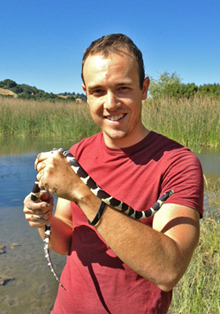
About Jonathan
Jonathan completed his doctorate in Ecology from UC Davis in June 2016. He is now a biologist with the USGS studying threatened and endangered species. Jonathan has always been fascinated by wildlife, particularly reptiles and amphibians. In his work, he seeks to apply ecological science to the conservation of biodiversity. Specifically, he is interested in integrating empirical studies with population modeling to inform conservation and management efforts for invasive and imperiled species in highly altered habitats.
For his dissertation work, Jonathan studied the invasion risk posed by two species of watersnakes (Nerodia fasciata and Nerodia sipedon) recently introduced to California. He used Species Distribution Models (SDM) to project the potential range of these species in California. He also conducted a four year capture-mark-recapture study of the non-native N. sipedon population in Roseville, California to study the demography of this species and its response to an extreme drought. He integrated the results of his field work with published data on the demography of N. sipedon in its native range to construct an Integral Projection Model and identify critical life stage transitions that influence population growth in this species. His work has informed efforts by state and federal wildlife agencies to control this incipient invasion before watersnakes can threaten California’s native aquatic wildlife.
Examples of recent publications
Rose JP, Todd BD. 2014. Projecting invasion risk of non-native watersnakes (Nerodia fasciataand Nerodia sipedon) in the western United States. PLoS ONE 9(6):e100277.
Rose JP, Miano OJ, Todd BD. 2013. Trapping efficiency, demography, and density of an introduced population of Northern Watersnakes, Nerodia sipedon, in California. Journal of Herpetology 47(3):421-427.
Rose JP, Malanson GP. 2012. Microtopographic heterogeneity constrains alpine plant diversity, Glacier National Park, MT. Plant Ecology 213(6):955-965.
